My
List |
Addition Date
|
Target
|
Mission
|
Instrument
|
Size
|

|
2024-06-10 |
Sol (our sun)
|
Mars 2020 Rover
|
Mastcam-Z
|
256x256x3 |
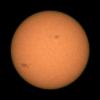
|
-
PIA26301:
-
Perseverance Views Sunspots
Full Resolution:
TIFF
(83.3 kB)
JPEG
(5.605 kB)
|

|
2023-02-09 |
Sol (our sun)
|
NuSTAR
|
|
2000x2000x3 |
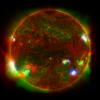
|
-
PIA25628:
-
Three-Telescope View of the Sun
Full Resolution:
TIFF
(8.903 MB)
JPEG
(217.5 kB)
|

|
2019-03-11 |
Sol (our sun)
|
SDO
|
Atmosphere Imaging Assembly
|
1500x1414x3 |
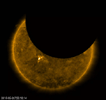
|
-
PIA21905:
-
Criss-Crossing Lunar Transit

Full Resolution:
TIFF
(2.274 MB)
JPEG
(92.56 kB)
|

|
2019-03-04 |
Sol (our sun)
|
SDO
|
Atmosphere Imaging Assembly
|
1520x1500x3 |
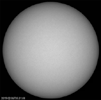
|
-
PIA21218:
-
Spotless February

Full Resolution:
TIFF
(1.689 MB)
JPEG
(190.5 kB)
|

|
2019-02-19 |
Sol (our sun)
|
SDO
|
Atmosphere Imaging Assembly
|
1650x1540x3 |
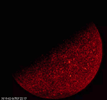
|
-
PIA21213:
-
Spring 2019 Eclipse Season Arrives

Full Resolution:
TIFF
(2.94 MB)
JPEG
(152.9 kB)
|

|
2018-12-24 |
Sol (our sun)
|
SDO
|
Atmosphere Imaging Assembly
|
1800x1800x3 |
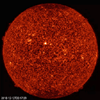
|
-
PIA21212:
-
Small Prominences

Full Resolution:
TIFF
(5.751 MB)
JPEG
(400 kB)
|

|
2018-12-11 |
Sol (our sun)
|
SDO
|
Atmosphere Imaging Assembly
|
1650x1650x3 |
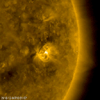
|
-
PIA21211:
-
Solar Active Region's Cameo Appearance

Full Resolution:
TIFF
(4.752 MB)
JPEG
(146 kB)
|

|
2018-12-05 |
Sol (our sun)
|
SDO
|
Atmosphere Imaging Assembly
|
1500x1500x3 |
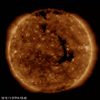
|
-
PIA18144:
-
Reappearing Coronal Hole

Full Resolution:
TIFF
(4.192 MB)
JPEG
(145.1 kB)
|

|
2018-11-19 |
Sol (our sun)
|
SDO
|
Atmosphere Imaging Assembly
|
1800x1800x3 |
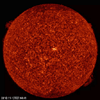
|
-
PIA18143:
-
Opposing Solar Prominences

Full Resolution:
TIFF
(5.168 MB)
JPEG
(372.5 kB)
|

|
2018-11-14 |
Sol (our sun)
|
SDO
|
Atmosphere Imaging Assembly
|
1628x1587x3 |
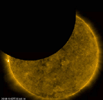
|
-
PIA18142:
-
SDO Observes a Partial Lunar Eclipse

Full Resolution:
TIFF
(3.473 MB)
JPEG
(139.1 kB)
|

|
2018-11-12 |
Sol (our sun)
|
SDO
|
Atmosphere Imaging Assembly
|
1445x1445x3 |
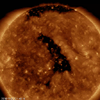
|
-
PIA18141:
-
Central Coronal Hole

Full Resolution:
TIFF
(4.566 MB)
JPEG
(155.4 kB)
|

|
2018-10-29 |
Sol (our sun)
|
SDO
|
Atmosphere Imaging Assembly
|
1770x1765x3 |
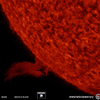
|
-
PIA18140:
-
Eruptive Prominence

Full Resolution:
TIFF
(3.695 MB)
JPEG
(240.5 kB)
|

|
2018-10-17 |
Sol (our sun)
|
SDO
|
Atmosphere Imaging Assembly
|
1668x1668x3 |
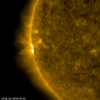
|
-
PIA18139:
-
Sole Active Region in Profile

Full Resolution:
TIFF
(4.272 MB)
JPEG
(150.1 kB)
|

|
2018-09-24 |
Sol (our sun)
|
SDO
|
Atmosphere Imaging Assembly
|
1800x1800x3 |
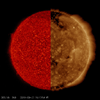
|
-
PIA22724:
-
Two Wavelengths, Two Different Images

Full Resolution:
TIFF
(5.585 MB)
JPEG
(262.9 kB)
|

|
2018-09-17 |
Sol (our sun)
|
SDO
|
Atmosphere Imaging Assembly
|
1800x1800x3 |
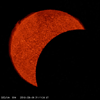
|
-
PIA22723:
-
Double Lunar Transit

Full Resolution:
TIFF
(2.063 MB)
JPEG
(142 kB)
|

|
2018-09-17 |
Sol (our sun)
|
SDO
|
Atmosphere Imaging Assembly
|
1500x1500x3 |
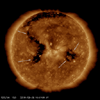
|
-
PIA22722:
-
Emerging Coronal Hole

Full Resolution:
TIFF
(3.545 MB)
JPEG
(135.6 kB)
|

|
2018-09-03 |
Sol (our sun)
|
SDO
|
Atmosphere Imaging Assembly
|
1780x1750x3 |
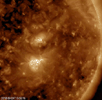
|
-
PIA22680:
-
New Active Region Grows Up

Full Resolution:
TIFF
(6.915 MB)
JPEG
(212.3 kB)
|

|
2018-08-20 |
Sol (our sun)
|
SDO
|
Atmosphere Imaging Assembly
|
1498x1500x3 |
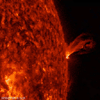
|
-
PIA22673:
-
Twisting Outburst

Full Resolution:
TIFF
(3.898 MB)
JPEG
(196.1 kB)
|

|
2018-08-14 |
Sol (our sun)
|
SDO
|
Atmosphere Imaging Assembly
|
1800x1800x3 |
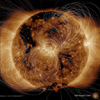
|
-
PIA22662:
-
Magnetic Field Portrayed

Full Resolution:
TIFF
(8.707 MB)
JPEG
(757.2 kB)
|

|
2018-08-07 |
Sol (our sun)
|
SDO
|
Atmosphere Imaging Assembly
|
1687x1684x3 |
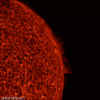
|
-
PIA22661:
-
Twisting Prominences

Full Resolution:
TIFF
(3.843 MB)
JPEG
(231.7 kB)
|

|
2018-07-31 |
Sol (our sun)
|
SDO
|
Atmosphere Imaging Assembly
|
1740x1635x1 |

|
-
PIA22646:
-
An Almost Spotless Record

Full Resolution:
TIFF
(1.411 MB)
JPEG
(157.9 kB)
|

|
2018-07-24 |
Sol (our sun)
|
SDO
|
Atmosphere Imaging Assembly
|
1669x1669x3 |
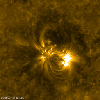
|
-
PIA22645:
-
Detailed Loops Above an Active Region

Full Resolution:
TIFF
(4.775 MB)
JPEG
(171.4 kB)
|

|
2018-07-17 |
Sol (our sun)
|
SDO
|
Atmosphere Imaging Assembly
|
1770x1632x3 |
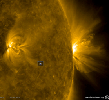
|
-
PIA22589:
-
Festoons of Loops

Full Resolution:
TIFF
(4.784 MB)
JPEG
(157.8 kB)
|

|
2018-07-05 |
Sol (our sun)
|
SDO
|
Atmosphere Imaging Assembly
|
1794x1632x3 |
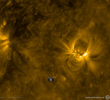
|
-
PIA22582:
-
Rambunctious Active Region

Full Resolution:
TIFF
(4.548 MB)
JPEG
(173.5 kB)
|

|
2018-06-26 |
Sol (our sun)
|
SDO
|
Atmosphere Imaging Assembly
|
1800x1567x3 |
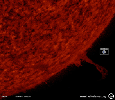
|
-
PIA22537:
-
Evolving Prominence

Full Resolution:
TIFF
(3.348 MB)
JPEG
(199.1 kB)
|

|
2018-06-11 |
Sol (our sun)
|
SDO
|
Atmosphere Imaging Assembly
|
1425x1425x3 |
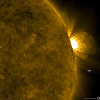
|
-
PIA22508:
-
Ballet of Loops

Full Resolution:
TIFF
(3.74 MB)
JPEG
(131 kB)
|

|
2018-06-04 |
Sol (our sun)
|
SDO
|
Atmosphere Imaging Assembly
|
1788x1651x3 |
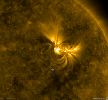
|
-
PIA22475:
-
Dynamic Looping Action

Full Resolution:
TIFF
(4.859 MB)
JPEG
(188 kB)
|

|
2018-05-29 |
Sol (our sun)
|
SDO
|
Atmosphere Imaging Assembly
|
1924x1794x3 |
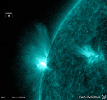
|
-
PIA22461:
-
New Active Region Sputtering with Small Flares

Full Resolution:
TIFF
(7.438 MB)
JPEG
(293.7 kB)
|

|
2018-05-22 |
Sol (our sun)
|
SDO
|
Atmosphere Imaging Assembly
|
1500x1500x3 |
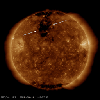
|
-
PIA00575:
-
Coronal Hole Rotating Towards Us

Full Resolution:
TIFF
(3.548 MB)
JPEG
(125 kB)
|

|
2018-05-15 |
Sol (our sun)
|
SDO
|
Atmosphere Imaging Assembly
|
1500x1332x3 |
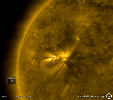
|
-
PIA00577:
-
Coronal Hole Facing Earth

Full Resolution:
TIFF
(3.339 MB)
JPEG
(130 kB)
|

|
2018-05-08 |
Sol (our sun)
|
SDO
|
Atmosphere Imaging Assembly
|
1641x1641x3 |
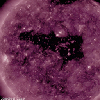
|
-
PIA00624:
-
Coronal Hole Facing Earth

Full Resolution:
TIFF
(6.335 MB)
JPEG
(299.4 kB)
|

|
2018-05-01 |
Sol (our sun)
|
SDO
|
Atmosphere Imaging Assembly
|
1650x1650x3 |

|
-
PIA22449:
-
Tangled Up in Blue

Full Resolution:
TIFF
(6.549 MB)
JPEG
(427.3 kB)
|

|
2018-04-23 |
Sol (our sun)
|
SDO
|
Atmosphere Imaging Assembly
|
1500x1493x3 |
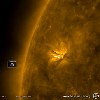
|
-
PIA22430:
-
Active Region Coming Around the Bend

Full Resolution:
TIFF
(3.819 MB)
JPEG
(114.4 kB)
|

|
2018-04-20 |
Sol (our sun)
|
SDO
|
Atmosphere Imaging Assembly
|
1473x1473x3 |
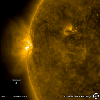
|
-
PIA06676:
-
Small but Dynamic Active Region

Full Resolution:
TIFF
(3.662 MB)
JPEG
(131.2 kB)
|

|
2018-04-16 |
Sol (our sun)
|
SDO
|
Atmosphere Imaging Assembly
|
1650x1650x3 |
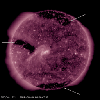
|
-
PIA22414:
-
Three Coronal Holes

Full Resolution:
TIFF
(4.104 MB)
JPEG
(179.7 kB)
|

|
2018-04-09 |
Sol (our sun)
|
SDO
|
Atmosphere Imaging Assembly
|
1800x1662x3 |
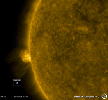
|
-
PIA22411:
-
Wavelength Comparisons

Full Resolution:
TIFF
(5.735 MB)
JPEG
(162.3 kB)
|

|
2018-04-02 |
Sol (our sun)
|
SDO
|
Atmosphere Imaging Assembly
|
1800x1800x3 |
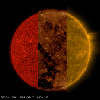
|
-
PIA22360:
-
Wavelength Comparisons

Full Resolution:
TIFF
(5.55 MB)
JPEG
(192.7 kB)
|

|
2018-03-19 |
Sol (our sun)
|
SDO
|
Atmosphere Imaging Assembly
|
1708x1620x3 |
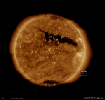
|
-
PIA22345:
-
Elongated Coronal Hole

Full Resolution:
TIFF
(3.231 MB)
JPEG
(125.5 kB)
|

|
2018-03-06 |
Sol (our sun)
|
SDO
|
Atmosphere Imaging Assembly
|
1800x1653x3 |
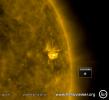
|
-
PIA22260:
-
Small Bursts
Full Resolution:
TIFF
(4.352 MB)
JPEG
(141.5 kB)
|

|
2018-02-16 |
Sol (our sun)
|
SDO
|
Atmosphere Imaging Assembly
|
1650x1627x3 |
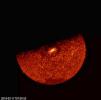
|
-
PIA22259:
-
SDO's Version of an Eclipse
Full Resolution:
TIFF
(1.681 MB)
JPEG
(136.5 kB)
|

|
2018-02-15 |
Sol (our sun)
|
SDO
|
Atmosphere Imaging Assembly
|
1571x1480x3 |
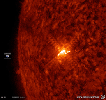
|
-
PIA22244:
-
One Small Flare

Full Resolution:
TIFF
(3.486 MB)
JPEG
(180.6 kB)
|

|
2018-02-07 |
Sol (our sun)
|
SDO
|
Atmosphere Imaging Assembly
|
1500x1500x3 |
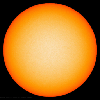
|
-
PIA22242:
-
Spotless Days

Full Resolution:
TIFF
(4.791 MB)
JPEG
(168 kB)
|

|
2018-01-31 |
Sol (our sun)
|
SDO
|
Atmosphere Imaging Assembly
|
1630x1630x3 |
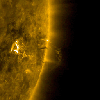
|
-
PIA22184:
-
Small Flare and a Coronal Mass Ejection

Full Resolution:
TIFF
(3.803 MB)
JPEG
(126.8 kB)
|

|
2018-01-18 |
Sol (our sun)
|
SDO
|
Atmosphere Imaging Assembly
|
1500x1602x3 |

|
-
PIA22199:
-
Reversing Prominence

Full Resolution:
TIFF
(3.541 MB)
JPEG
(214.3 kB)
|

|
2018-01-12 |
Sol (our sun)
|
SDO
|
Atmosphere Imaging Assembly
|
1629x1634x3 |
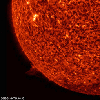
|
-
PIA22198:
-
Small Twisting Prominence

Full Resolution:
TIFF
(4.534 MB)
JPEG
(316.9 kB)
|

|
2017-12-29 |
Sol (our sun)
|
SDO
|
Atmosphere Imaging Assembly
|
1783x1780x3 |
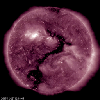
|
-
PIA22197:
-
The Sun Forms a Question

Full Resolution:
TIFF
(5.955 MB)
JPEG
(230.3 kB)
|

|
2017-12-18 |
Sol (our sun)
|
SDO
|
Atmosphere Imaging Assembly
|
1500x1500x3 |
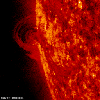
|
-
PIA22196:
-
Curling Prominence

Full Resolution:
TIFF
(3.129 MB)
JPEG
(225.7 kB)
|

|
2017-12-15 |
Sol (our sun)
|
SDO
|
Atmosphere Imaging Assembly
|
1483x1463x3 |
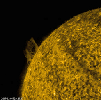
|
-
PIA22195:
-
Prominence Falls Apart

Full Resolution:
TIFF
(4.213 MB)
JPEG
(260.2 kB)
|

|
2017-12-11 |
Sol (our sun)
|
SDO
|
Atmosphere Imaging Assembly
|
1630x1632x3 |
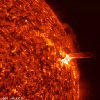
|
-
PIA22123:
-
Slithering Prominence

Full Resolution:
TIFF
(5.042 MB)
JPEG
(264.7 kB)
|

|
2017-11-28 |
Sol (our sun)
|
SDO
|
Atmosphere Imaging Assembly
|
1650x1650x3 |
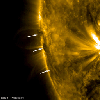
|
-
PIA22120:
-
Churning Filament

Full Resolution:
TIFF
(4.195 MB)
JPEG
(161.9 kB)
|

|
2017-11-16 |
Sol (our sun)
|
SDO
|
Atmosphere Imaging Assembly
|
1500x1500x3 |
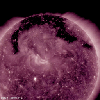
|
-
PIA22113:
-
Coronal Hole All Spread Out

Full Resolution:
TIFF
(4.795 MB)
JPEG
(223.3 kB)
|

|
2017-11-08 |
Sol (our sun)
|
SDO
|
Atmosphere Imaging Assembly
|
1500x1500x3 |
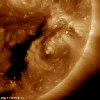
|
-
PIA22104:
-
Rare Encircling Filament

Full Resolution:
TIFF
(4.554 MB)
JPEG
(133 kB)
|

|
2017-10-31 |
Sol (our sun)
|
SDO
|
Atmosphere Imaging Assembly
|
2400x1707x3 |
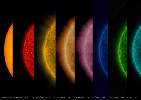
|
-
PIA22055:
-
From Hot to Hottest

Full Resolution:
TIFF
(6.995 MB)
JPEG
(252.6 kB)
|

|
2017-10-23 |
Sol (our sun)
|
SDO
|
Atmosphere Imaging Assembly
|
1800x1902x3 |

|
-
PIA22050:
-
Quick Solar Outburst

Full Resolution:
TIFF
(6.312 MB)
JPEG
(178.9 kB)
|

|
2017-10-16 |
Sol (our sun)
|
SDO
|
Atmosphere Imaging Assembly
|
1800x1631x3 |
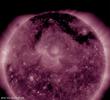
|
-
PIA22047:
-
Sprawling Coronal Hole
Full Resolution:
TIFF
(6.592 MB)
JPEG
(254.2 kB)
|

|
2017-10-09 |
Sol (our sun)
|
SDO
|
Atmosphere Imaging Assembly
|
1650x1650x3 |
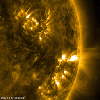
|
-
PIA22039:
-
Dynamic Duo

Full Resolution:
TIFF
(7.304 MB)
JPEG
(242.3 kB)
|

|
2017-10-04 |
Sol (our sun)
|
SDO
|
Atmosphere Imaging Assembly
|
1440x1440x3 |
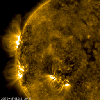
|
-
PIA22038:
-
Trio of Tempests

Full Resolution:
TIFF
(3.855 MB)
JPEG
(181.5 kB)
|

|
2017-09-18 |
Sol (our sun)
|
SDO
|
Atmosphere Imaging Assembly
|
1800x1600x3 |
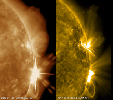
|
-
PIA21958:
-
Major Solar Flare

Full Resolution:
TIFF
(5.49 MB)
JPEG
(203.4 kB)
|

|
2017-09-11 |
Sol (our sun)
|
SDO
|
Atmosphere Imaging Assembly
|
1800x1800x3 |
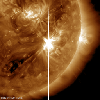
|
-
PIA21949:
-
Major Solar Flare

Full Resolution:
TIFF
(6.065 MB)
JPEG
(233.6 kB)
|

|
2017-09-02 |
Sol (our sun)
|
SDO
|
Atmosphere Imaging Assembly
|
1500x1547x3 |
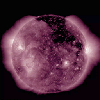
|
-
PIA21942:
-
Extensive Coronal Hole

Full Resolution:
TIFF
(4.019 MB)
JPEG
(155.5 kB)
|

|
2017-08-23 |
Sol (our sun)
|
SDO
|
Atmosphere Imaging Assembly
|
1744x1800x3 |
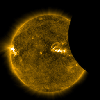
|
-
PIA21929:
-
SDO Saw Only a Partial Eclipse

Full Resolution:
TIFF
(3.667 MB)
JPEG
(185.9 kB)
|

|
2017-08-14 |
Sol (our sun)
|
SDO
|
Atmosphere Imaging Assembly
|
1800x1800x3 |
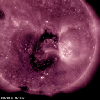
|
-
PIA21874:
-
Coronal Hole Faces Earth

Full Resolution:
TIFF
(7.349 MB)
JPEG
(255.3 kB)
|

|
2017-08-07 |
Sol (our sun)
|
SDO
|
Atmosphere Imaging Assembly
|
1500x1500x3 |
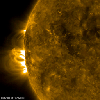
|
-
PIA21873:
-
Old Sunspot Returns

Full Resolution:
TIFF
(4.347 MB)
JPEG
(148.5 kB)
|

|
2017-08-01 |
Sol (our sun)
|
SDO
|
Atmosphere Imaging Assembly
|
1500x1500x3 |
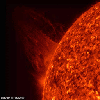
|
-
PIA21866:
-
Sheet of Plasma

Full Resolution:
TIFF
(4.421 MB)
JPEG
(207.7 kB)
|

|
2017-07-25 |
Sol (our sun)
|
SDO
|
Atmosphere Imaging Assembly
|
1500x1501x3 |
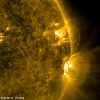
|
-
PIA21838:
-
Kinked Loop Stretching Between Two Active Regions

Full Resolution:
TIFF
(4.055 MB)
JPEG
(189.1 kB)
|

|
2017-07-18 |
Sol (our sun)
|
SDO
|
Atmosphere Imaging Assembly
|
1500x1500x3 |
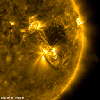
|
-
PIA21836:
-
Bastille Day Solar Flare and a Coronal Mass Ejection

Full Resolution:
TIFF
(4.226 MB)
JPEG
(181.7 kB)
|

|
2017-07-12 |
Sol (our sun)
|
SDO
|
Atmosphere Imaging Assembly
|
1800x1800x1 |
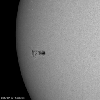
|
-
PIA21783:
-
New Lone Sunspot Group

Full Resolution:
TIFF
(2.249 MB)
JPEG
(255.9 kB)
|

|
2017-07-05 |
Sol (our sun)
|
SDO
|
Atmosphere Imaging Assembly
|
1636x1500x3 |
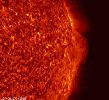
|
-
PIA21768:
-
Streaming Prominence

Full Resolution:
TIFF
(4.314 MB)
JPEG
(261.6 kB)
|

|
2017-06-27 |
Sol (our sun)
|
SDO
|
Atmosphere Imaging Assembly
|
1483x1357x3 |
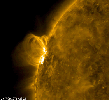
|
-
PIA21764:
-
Coils of Magnetic Field Lines

Full Resolution:
TIFF
(3.194 MB)
JPEG
(106.3 kB)
|

|
2017-06-19 |
Sol (our sun)
|
SDO
|
Atmosphere Imaging Assembly
|
1500x1500x3 |
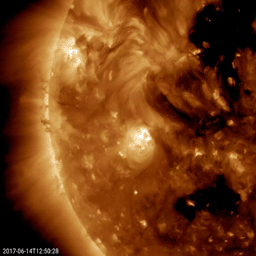
|
-
PIA21761:
-
Twisting Plasma Interactions

Full Resolution:
TIFF
(5.565 MB)
JPEG
(200.4 kB)
|

|
2017-06-02 |
Sol (our sun)
|
SDO
|
Atmosphere Imaging Assembly
|
1500x1500x3 |
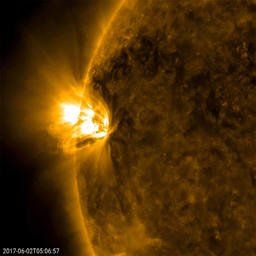
|
-
PIA21756:
-
Energized Active Regions

Full Resolution:
TIFF
(4.269 MB)
JPEG
(134.4 kB)
|

|
2017-05-30 |
Sol (our sun)
|
SDO
|
Atmosphere Imaging Assembly
|
1500x1500x3 |
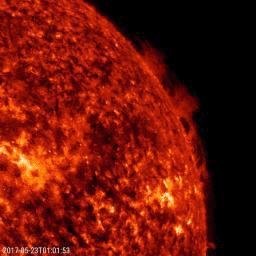
|
-
PIA21650:
-
Hedgerow Prominence

Full Resolution:
TIFF
(4.238 MB)
JPEG
(270.8 kB)
|

|
2017-05-22 |
Sol (our sun)
|
SDO
|
Atmosphere Imaging Assembly
|
1500x1500x3 |

|
-
PIA21638:
-
Active Regions' Magnetic Connection

Full Resolution:
TIFF
(4.356 MB)
JPEG
(148.6 kB)
|

|
2017-05-16 |
Sol (our sun)
|
SDO
|
Atmosphere Imaging Assembly
|
1484x1484x3 |
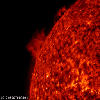
|
-
PIA21634:
-
Two Prominences Unraveling

Full Resolution:
TIFF
(2.682 MB)
JPEG
(192.6 kB)
|

|
2017-05-09 |
Sol (our sun)
|
SDO
|
Atmosphere Imaging Assembly
|
1500x1520x3 |

|
-
PIA21632:
-
Shifting Plasma

Full Resolution:
TIFF
(3.975 MB)
JPEG
(262.6 kB)
|

|
2017-05-01 |
Sol (our sun)
|
SDO
|
Atmosphere Imaging Assembly
|
1440x1444x3 |
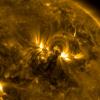
|
-
PIA21604:
-
Solar Golden Arches
Full Resolution:
TIFF
(5.45 MB)
JPEG
(178.6 kB)
|

|
2017-04-24 |
Sol (our sun)
|
SDO
|
Atmosphere Imaging Assembly
|
720x755x3 |

|
-
PIA21598:
-
Cascading Post-coronal Loops
Full Resolution:
TIFF
(1.543 MB)
JPEG
(60.73 kB)
|

|
2017-04-18 |
Sol (our sun)
|
SDO
|
Atmosphere Imaging Assembly
|
1500x1500x3 |
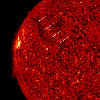
|
-
PIA21592:
-
Filament Breakaway

Full Resolution:
TIFF
(3.207 MB)
JPEG
(274.8 kB)
|

|
2017-04-11 |
Sol (our sun)
|
SDO
|
Atmosphere Imaging Assembly
|
1500x1500x3 |
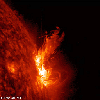
|
-
PIA21584:
-
Flares in Profile

Full Resolution:
TIFF
(2.975 MB)
JPEG
(126.2 kB)
|

|
2017-03-28 |
Sol (our sun)
|
SDO
|
Atmosphere Imaging Assembly
|
2100x1181x3 |
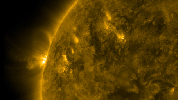
|
-
PIA21583:
-
Dynamic Loops in Profile

Full Resolution:
TIFF
(4.186 MB)
JPEG
(182.8 kB)
|

|
2017-03-20 |
Sol (our sun)
|
SDO
|
Atmosphere Imaging Assembly
|
1500x1478x3 |
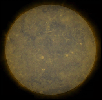
|
-
PIA21582:
-
Spotless Sun

Full Resolution:
TIFF
(4.696 MB)
JPEG
(122.5 kB)
|

|
2017-03-16 |
Sol (our sun)
|
SDO
|
Atmosphere Imaging Assembly
|
1500x1500x3 |
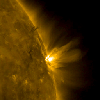
|
-
PIA21562:
-
Stretched Loops

Full Resolution:
TIFF
(3.351 MB)
JPEG
(91.7 kB)
|

|
2017-03-08 |
Sol (our sun)
|
SDO
|
Atmosphere Imaging Assembly
|
2400x2400x3 |
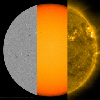
|
-
PIA21557:
-
Sorting through Layers

Full Resolution:
TIFF
(11.85 MB)
JPEG
(719.2 kB)
|

|
2017-02-28 |
Sol (our sun)
|
SDO
|
Atmosphere Imaging Assembly
|
1800x1575x3 |
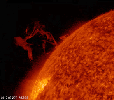
|
-
PIA21552:
-
Delicate Ballet

Full Resolution:
TIFF
(4.835 MB)
JPEG
(198.5 kB)
|

|
2017-02-21 |
Sol (our sun)
|
SDO
|
Atmosphere Imaging Assembly
|
1500x944x3 |
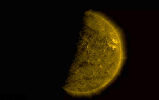
|
-
PIA21461:
-
Earth Eclipses the Sun

Full Resolution:
TIFF
(1.273 MB)
JPEG
(62.33 kB)
|

|
2017-02-06 |
Sol (our sun)
|
SDO
|
Atmosphere Imaging Assembly
|
1500x1500x3 |
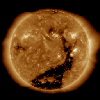
|
-
PIA11177:
-
Returning Coronal Hole

Full Resolution:
TIFF
(3.801 MB)
JPEG
(138.7 kB)
|

|
2017-01-30 |
Sol (our sun)
|
SDO
|
Atmosphere Imaging Assembly
|
1500x1500x3 |
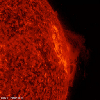
|
-
PIA11237:
-
Churning Prominence

Full Resolution:
TIFF
(4.432 MB)
JPEG
(220.6 kB)
|

|
2017-01-26 |
Sol (our sun)
|
SDO
|
Atmosphere Imaging Assembly
|
1500x1500x3 |
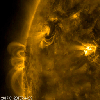
|
-
PIA11703:
-
Gyrating Active Region

Full Resolution:
TIFF
(4.472 MB)
JPEG
(141.6 kB)
|

|
2017-01-17 |
Sol (our sun)
|
SDO
|
Atmosphere Imaging Assembly
|
1500x1500x3 |
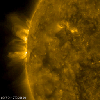
|
-
PIA12327:
-
Organized Arches

Full Resolution:
TIFF
(4.328 MB)
JPEG
(135 kB)
|

|
2017-01-09 |
Sol (our sun)
|
SDO
|
Atmosphere Imaging Assembly
|
-1x-1x3 |
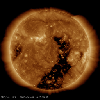
|
-
PIA14093:
-
Lengthy Coronal Hole

Full Resolution:
TIFF
(7.362 MB)
JPEG
(273.3 kB)
|

|
2017-01-03 |
Sol (our sun)
|
SDO
|
Atmosphere Imaging Assembly
|
2400x1404x3 |
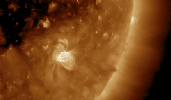
|
-
PIA15032:
-
Jumpy Active Region

Full Resolution:
TIFF
(5.395 MB)
JPEG
(180.7 kB)
|

|
2016-12-14 |
Sol (our sun)
|
SDO
|
Atmosphere Imaging Assembly
|
2100x1181x3 |
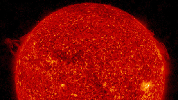
|
-
PIA15301:
-
Both Sides Now

Full Resolution:
TIFF
(3.383 MB)
JPEG
(354.1 kB)
|

|
2016-12-06 |
Sol (our sun)
|
SDO
|
Atmosphere Imaging Assembly
|
2400x1350x3 |
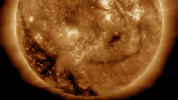
|
-
PIA21208:
-
Coronal Hole Coming Around

Full Resolution:
TIFF
(5.501 MB)
JPEG
(216.2 kB)
|

|
2016-11-30 |
Sol (our sun)
|
SDO
|
Atmosphere Imaging Assembly
|
2025x2025x1 |
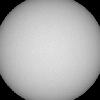
|
-
PIA21207:
-
Almost Spotless

Full Resolution:
TIFF
(3.09 MB)
JPEG
(340.3 kB)
|

|
2016-11-09 |
Sol (our sun)
|
SDO
|
Atmosphere Imaging Assembly
|
1200x645x3 |
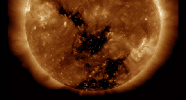
|
-
PIA16909:
-
Earth-Facing Coronal Holes

Full Resolution:
TIFF
(1.704 MB)
JPEG
(57.05 kB)
|

|
2016-11-04 |
Sol (our sun)
|
SDO
|
Atmosphere Imaging Assembly
|
1487x990x3 |
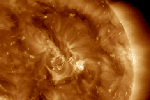
|
-
PIA21202:
-
Small Surf

Full Resolution:
TIFF
(3.183 MB)
JPEG
(114.7 kB)
|

|
2016-10-27 |
Sol (our sun)
|
SDO
|
Atmosphere Imaging Assembly
|
1200x1200x3 |
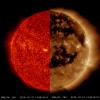
|
-
PIA15377:
-
Wavelength Comparison
Full Resolution:
TIFF
(2.998 MB)
JPEG
(137.2 kB)
|

|
2016-10-21 |
Sol (our sun)
|
SDO
|
Atmosphere Imaging Assembly
|
3300x1854x3 |
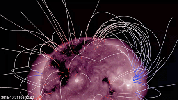
|
-
PIA15378:
-
Substantial Coronal Holes

Full Resolution:
TIFF
(8.71 MB)
JPEG
(492.2 kB)
|

|
2016-10-11 |
Sol (our sun)
|
SDO
|
Atmosphere Imaging Assembly
|
1800x1445x3 |
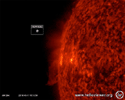
|
-
PIA21109:
-
Agitated Active Region

Full Resolution:
TIFF
(3.63 MB)
JPEG
(152.3 kB)
|

|
2016-10-04 |
Sol (our sun)
|
SDO
|
Atmosphere Imaging Assembly
|
2400x1331x3 |
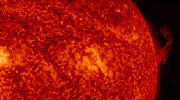
|
-
PIA21106:
-
Bendable Prominence

Full Resolution:
TIFF
(9.203 MB)
JPEG
(470.5 kB)
|

 Planetary Data System
Planetary Data System



















































































































